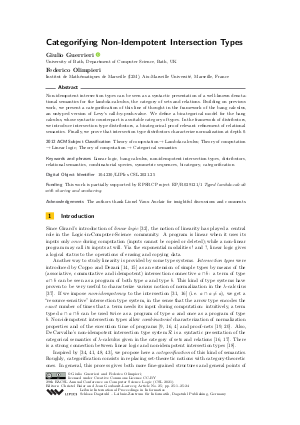LIPIcs.CSL.2021.25.pdf
- Filesize: 0.66 MB
- 24 pages

 Creative Commons Attribution 3.0 Unported license
Creative Commons Attribution 3.0 Unported license

Non-idempotent intersection types can be seen as a syntactic presentation of a well-known denotational semantics for the lambda-calculus, the category of sets and relations. Building on previous work, we present a categorification of this line of thought in the framework of the bang calculus, an untyped version of Levy’s call-by-push-value. We define a bicategorical model for the bang calculus, whose syntactic counterpart is a suitable category of types. In the framework of distributors, we introduce intersection type distributors, a bicategorical proof relevant refinement of relational semantics. Finally, we prove that intersection type distributors characterize normalization at depth 0.






Feedback for Dagstuhl Publishing